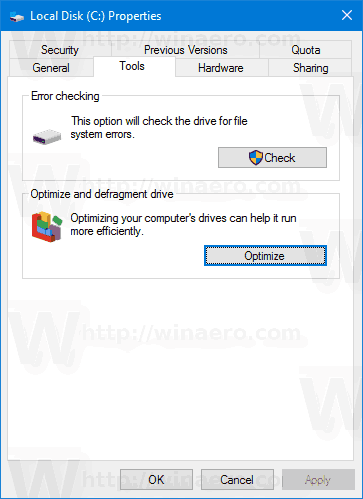In order to minimize slow hard drive performance, (and so Windows 8.1, Windows 7, and previous versions), includes a built-in tool to defragment all fragmented files and help your PC stay at top speeds.Over the years, improvements have been made to the Windows drive optimization tool. However, even when the operating system can accurately detect the type of storage and handle defragmentation of files automatically, it's not always optimal. Because you may not keep your PC turned on long enough or you may have an external hard drive that it's not always connected to your computer that prevents maintenance from running properly.As a result, the time will come when you'll begin to notice that opening apps and saving files to disk will take longer than usual, in which case manual optimization may be required. In this, we'll show you the easy steps to check if your hard drive is fragmented and defragment as necessary to keep your computer running more efficiently.
System Drive Needs Optimization Windows 10 0
On the system windows, click advanced system settings. On the System Properties window and under the Advanced tab. Click the Settings inside the Performance box. On the Performance Options windows. Click Advanced tab then click Change. On the Virtual Memory windows. Uncheck the Automatically Manage Paging File Size on all Drives. Defragment your Windows 10 PC. Content provided by Microsoft. Applies to: Windows 10. Select the search bar on the taskbar and enter defrag. Select Defragment and Optimize Drives. Select the disk drive you want to optimize. Select the Optimize button. Last Updated: Nov 20, 2017. Email this article; Print; Subscribe RSS Feeds. Copy URL into.
How to use Optimize Drives on Windows 10. Open Start type Defragment and Optimize Drives and press Enter.Select the hard drive you want to optimize and click Analyze.Note: You always want to analyze the drive first to figure out if the drive needs optimization. If the result shows less than 10% fragmented, you probably don't need to optimize the drive.If the files stored on your PC's hard drive are scattered everyone and defragmentation is needed, then click the Optimize button.Once the process complete, the current status should display '0% fragmented'.Note: Keep in mind that depending on the number of files, the size of the drive, and fragmentation, the defragmentation tool may take some time to complete the task. It's also recommended to perform this task when you know, you won't be around your computer.
What is Optimize and Defragment Hard Disk Drive in Windows 10?Optimization and defragment are the maintenance utilities in Windows 10 including the previous editions that. Hard disk drives are prone to get fragment after taking huge workload over the days.They find too tough to read the data in windows or take a long time. Eventually, the computer slows down and we feel uncomfortable to work along.In order to get rid of the clog, we need to optimize the windows by defragmenting it. This process might take a bit longer but repairs the drive that ends up with a boost up of the speed.The necessity of DefragmentHard disk consists of spinning platters and the data you store takes a place around these.


After you save files and folders they get arranged in sequence with blocks on each side of platters.Because of the fragmentation, data in the blocks split and divaricate from one another. The process puts all these broken parts together and arranges in the same fashion as it was earlier further.When do you need to Defragment Hard Disk Drive in Windows 10?Defragment is system maintenance you should run once found the device not performing as expected. It depends upon usage actually.
There is no hard and fast rule.
Most Popular News
- Prophesy Of Pendor Mercenary
- Toogoo 200 Mg X 0.01 G
- Drivers De Chipset Hyperionpro Via 5.24a, 22.01.2010
- Ev Tipi Vakitmatik Kumandal
- Methodology To Implement Crm Applications
- Lego Pirate Of The Caribbean Cheats
- Fallout 4 Legendary Railway Rifle
- Download Sap 2000 V14.2.2 Full Crack 64 Bit
- Comcast New Remote Instructions
- Deep Freeze Enterprise 7.72 Full Version With Key
- Tiger Skin For Minecraft
- Arlington 30 Something Meetup Boston
- Ufc Fight Night 148 Web-dl H264-fight-bb
- Morrowind Constant Effect Enchantments
- Change Cursor Size Windows 7
- Mass Effect 3 Palaven
- Domain Group Policy Block
- Balanced Version Pga2311 Preamp Board Volume Controller Instructions
- Can T Rename Folder Windows 10
- Assassin Creed Unity Download Pc
- Skyrim Snow Bear Armor
- Game Dev Tycoon Cheat Mod Download
- Enna Satham Indha Neram Lyrics
- Arts From Tuxbirds Prewiews
- Your Money Or Your Life Pdf